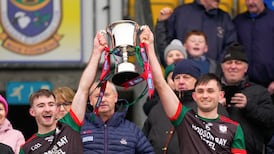Slaughtneil's Brendan Rodgers was running across to his left from his full-forward position, closely followed by Ballygunner's Barry Coughlan, one of the best defenders in the game.
As the ball rolled away from Rodgers towards the sideline he pulled on the ball between his legs, nutmegging himself and leaving Coughlan seemingly for dead. He turned on a sixpence, picked up the sliotar, advanced infield and only a despairing hook from the recovering defender denied him the point of the year so far.
My first thought was not, as is often the case, that we'd be raving about that if it was TJ Reid, or Joe Canning, or Patrick Horgan. My first thought was also not that that was a hell of a piece of attacking play for a guy who is a pretty no-nonsense defender in Gaelic football (there's no real reason why a defender in football should necessarily be a defender in hurling, but it appears I see playing in defence as a character defect that should be common across all codes.)
My first thought was – how does a guy from halfway up a mountain in Derry learn how to do that? I mean, really? This was an All-Ireland club hurling semi-final, not an exhibition. This was an exceptional piece of stick-work, in an extremely high-stakes game, against pretty much the best opposition you could ask for.
Oisín Mullin move to AFL side Geelong off after Mayo confirm his availability
Green proposal for football championship reform likely to get green light
Return to Cork and Munster summit completes long journey for St Finbarr’s
Seán Moran: the national football league can expect a hearty welcome this year
Slaughtneil brought plenty of aggression, plenty of fight to the game, but it was Rodgers's piece of skill that stayed with me. I don't want to patronise them, as that's happened plenty of times before. So it's only right I express my bafflement at how a game as infuriatingly dextrous as hurling can be mastered by someone like Rodgers.
When my brother moved to Athenry from our football-only community in north Galway, he felt honour-bound to ‘learn’ how to play hurling, just so he could puck around with his son and not allow any bad habits to fester.
He had messed around with hurleys in our backyard throughout his childhood. But in his head it was similar to having to relearn Irish before your child goes to a Gaelscoil. What’s the point in them receiving top-class instruction at school if the teaching couldn’t continue at home?
It was only then, as he learned how to correctly grip the hurley, how to jab lift the sliotar, that he realised just how complicated this all was, how much effort was required to make a hurler. That’s what Slaughtneil have managed to master.
Last weekend saw teams from Kildare, Mayo, Kerry and Derry play in the All-Ireland Intermediate championship semi-finals. These were the winners of the senior championship in those counties, up against the Intermediate champions in the major hurling counties, and coming up trumps – an extraordinary achievement.
Too often at around this time of year, when their provincial winners put it up to more ‘illustrious’ county champions, Ulster’s proselytisation of the game is lauded. This year the successes of Naas, Tooreen, and Kilmoyley bring the work done in those counties, and in others like them, more sharply into focus.
Too often, debate about why there aren’t more stories like Naas and Kilmoyley out there, spreading the hurling gospel, goes no further than questions about when those clubs would play the extra games, where they would find the room for more training sessions, and why they would bring further confusion into an already packed fixtures schedule.
These are all valid questions, but they stop us from asking a more fundamental question. Do we want this to happen? Do we want every kid who joins a GAA club to have a chance to sample both of our national sports?
We’re not talking about a nation full of Slaughtneils and Loughmore-Castleineys. We’re just talking about offering all the meats of the GAA stew. It seems a simple ambition to aim for, but the suspicion remains that for many units, counties as well as clubs, there exists no will whatsoever for hurling.
All the talk of it as the national sport rings pretty hollow when everything above the Dublin-Galway railway line is a desert. The tiered competitions in hurling are often lauded as the future for Gaelic football, but if you talk to the people competing at that level, more often than not they’re frustrated by the paucity of coverage, the indecent haste with which the games are played off in, and the fallen promise that the finals of those competitions were going to be played as part of the biggest days in the hurling calendar, as curtain-raisers to All-Ireland quarter- or semi-finals.
Communities like Tooreen and Kilmoyley have existed for decades as outposts of hurling in a Gaelic football county. Naas might be more accurately described as a growth market, strengthened no doubt by migration out from Dublin, but with challenges of its own to face, not least the traditional dominance of football in Kildare.
Instead of going straight to the reasons why it can’t happen in more places, we need to ask if it should. And if it should, then forget the problems. We owe it to ourselves to at least try.















